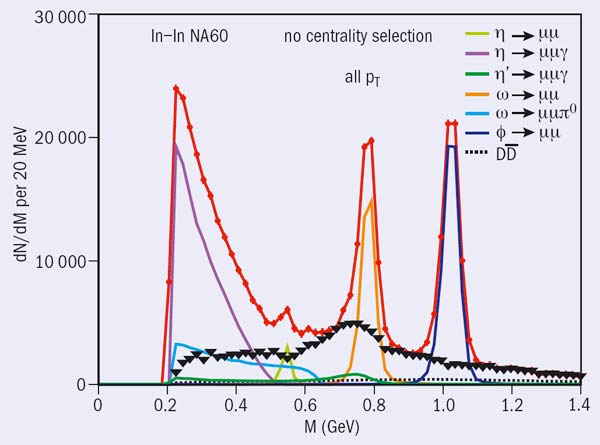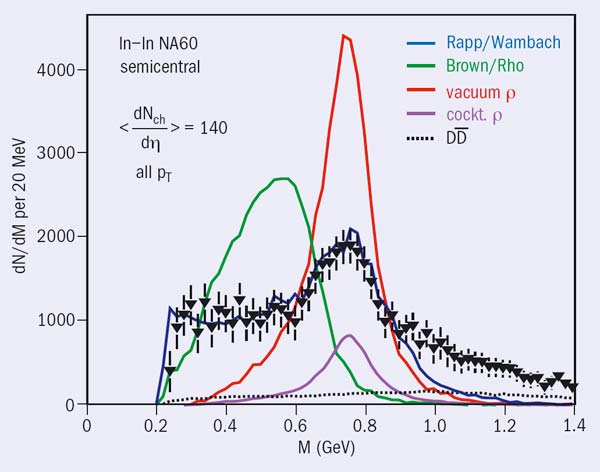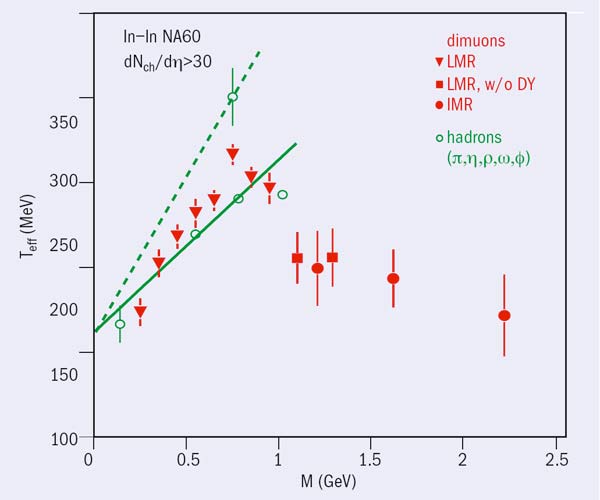Measurements reveal the thermal origin of dileptons in nuclear collisions at SPS energies.

Heavy-ion collisions at ultrarelativistic energies explore the transition from ordinary matter to a plasma of deconfined quarks and gluons – a state of matter that probably existed in the first few microseconds of the universe. Early experiments of this kind began 25 years ago at CERN, at the Super Proton Synchrotron (SPS), and at Brookhaven, at the Alternating Gradient Synchrotron followed by the Relativistic Heavy Ion Collider in 2000 – and now the LHC at CERN is preparing for heavy-ion collisions in 2010. Studies of the hadrons produced have given insight into numerous aspects of the medium formed in the collisions, including collective behaviour and thermalization. They have also indicated that the temperatures reached at beam energies above about 40A GeV may already exceed the critical temperature Tc for deconfinement into a quark-gluon plasma.
Electromagnetic probes such as photons and dileptons (l+l– pairs) have long held the promise of a more direct insight. Escaping without final-state interactions, they can reveal the entire space–time evolution of the produced medium, from the early partonic (quark–gluon) phase to the final freeze-out of hadrons, when all interactions cease. In the case of dileptons, experimental difficulties associated with low signal-to-background ratios (from high multiplicity densities), the superposition of nonthermal sources and a lack of sufficient luminosity have hindered clear insight in the past. Nevertheless, experiments at CERN observed an encouraging excess above known sources: CERES/NA45 in the mass region below 1 GeV, NA38/NA50 in the region above 1 GeV and HELIOS/NA34-3 in both mass regions. The very existence of an excess gave a strong boost to theory, leading to hundreds of publications, and provoked a number of open questions.

For masses below 1 GeV, thermal dilepton production is dominated by the hadronic phase and mediated mainly by the light vector meson ρ (770 MeV). With its strong coupling to μ+μ– and a lifetime of only 1.3 fm – much shorter than that of the “fireball” produced – the ρ is the key test particle for “in-medium” changes of hadron properties such as mass and width close to the transition where chiral symmetry is restored, as Robert Pisarski first proposed. However, questions about how the ρ changes in the medium – does it shift in mass or broaden? – remained open. Above 1 GeV, thermal dileptons could be produced as “Planck-like” continuum radiation in both the early partonic and late hadronic phases, so offering access to the expected deconfinement transition, as first Edward Shuryak, and later Keijo Kajantie and many others, have pointed out. However, the ori-gin of the dilepton-excess observed above 1 GeV was not clear. Does it arise from the enhanced production of open charm or from thermal radiation? Is it from partonic or hadronic sources? The status of thermal dilepton production in both mass regions at RHIC is even less clear.
Novel detectors
The NA60 experiment at CERN’s SPS was built specifically to follow up on these open questions. By taking a big step forward in technology this third-generation experiment has achieved completely new standards of data quality in the field. Approved in 2000, it took data on indium–indium collisions at 158A GeV for just one running period, in 2003. Briefly, the apparatus complements the muon spectrometer (MS) previously used by NA10/NA38/NA50 with a novel radiation-hard, silicon-pixel vertex telescope (VT), placed inside a 2.5 T dipole magnet between the target region and the hadron absorber (Arnaldi et al. 2009a). The VT tracks all of the charged particles before they enter the absorber and determines their momenta independently of the MS, free from multiple-scattering effects and the energy-loss fluctuations that occur in the absorber. The associated read-out pixel chips were originally developed for the ALICE and LHCb experiments.
The matching of the muon tracks in the VT and the MS, in both co-ordinate and momentum space, greatly improves the dimuon mass resolution in the region of the vector mesons ρ, ω, and φ, reducing it from approximately 80 MeV to around 20 MeV. It also significantly reduces the combinatorial background from μ and K decays and makes it possible to measure the muon offset with respect to the primary interaction vertex, thereby allowing the tagging of dimuons from simultaneous semileptonic decays of DDı pairs – that is, open charm. The additional bend by the dipole field gives a much greater acceptance for opposite-sign dimuons at low mass and low transverse momentum than was possible in all previous dimuon experiments. Finally, the selective dimuon trigger and the radiation-hard vertex tracker, with its high read-out speed, allowed the experiment to run at high rates for extended periods, enabling a high luminosity.
Low mass to high mass

Starting with the low mass region, M <1 GeV, figure 1 shows the net dimuon mass spectrum from NA60, integrated over centrality, after subtraction of the two main background sources: combinatorial background and fake matches between the two spectrometers (Arnaldi et al. 2006 and 2008). The plot contains about 440,000 dimuons in this mass region and exceeds previous results by up to three orders of magnitude in effective statistics, depending on mass. The spectrum is dominated by the known sources: the electromagnetic two-body decays of the η, ω and φ resonances, which are completely resolved for the first time in nuclear collisions, and the Dalitz decays of the η, η’ and ω. While the peripheral, “p–p like” data – the very glancing collisions – are quantitatively described by the sum of a “cocktail” of these contributions together with the ρ and open charm, this is not true for the more centrally weighted – more “head on” – total data shown in figure 1. This is because of the underlying dilepton excess observed previously.
Now, for the first time, the high data quality allows this excess to be isolated without any assumptions about its nature and without fits. The cocktail of decay sources is subtracted from the total data using local criteria that are based solely on the measured mass distribution itself; the ρ is not subtracted. Figure 2 shows the excess for one region in centrality (Arnaldi et al. 2006 and 2009b). The peaked structure seen here appears for all centralities, broadening strongly for the more central collisions, but remaining centred on the nominal pole position of the ρ. At the same time, the total yield relative to the cocktail ρ increases with centrality, becoming up to six times larger than for the most peripheral collisions.
All of this is consistent with an interpretation of the dilepton excess as arising predominantly from μ+μ– annihilation via intermediate ρ mesons, which are continuously regenerated throughout the hadronic phase of the expanding fireball. (This is the “ρ-clock”, which “ticks” at the rate of the ρ’s lifetime and is presumably the most accurate way to measure the lifetime of the fireball). It is important to point out that the data as plotted, i.e. without any acceptance correction and pT selection, can be directly interpreted as the space–time averaged spectral function of the ρ, owing to a fortuitous cancellation of the mass and pT dependence of the acceptance filtering by the photon propagator and Bose factor associated with thermal dilepton emission (Damjanovic et al. 2007).

Figure 2 also shows the two main theoretical scenarios for the in-medium spectral properties of the ρ: dropping mass, suggested by Gerald Brown and Mannque Rho, and broadening as proposed by Ralf Rapp, Jochen Wambach and colleagues. The dropping-mass scenario, which ties hadron masses directly to the value of the chiral condensate (with vanishing values as chiral restoration is approached), leads to a shifted and broadened distribution that is clearly ruled out. The unmodified ρ, defined as the full amount of regenerated ρ mesons without any in-medium spectral changes (“vacuum ρ”), is also clearly ruled out. Only the broadening scenario, based on a hadronic many-body approach, describes the data well, up to about 0.9 GeV where processes other than 2μ set in, as described below.
The results from NA60 thus end a decades-long controversy about the spectral properties of hadrons close to the QCD phase boundary. In general terms, chiral restoration should restore the degeneracy between chiral partners such as the vector ρ and the axialvector a1, which are normally split by 0.5 GeV. Whether this happens by moving masses or by a complete “melting” with full overlap of the two partners has always been open to debate, but the question is now answered for the ρ – and with it probably for all light hadrons. Meanwhile, a more explicit connection between chiral-symmetry restoration and the hadron “melting” observed is under discussion by Rapp, Wambach and others.
Turning now to the mass region above 1 GeV, the use of the silicon VT has allowed NA60 to measure the offset between the muon track and the primary interaction vertex and thereby disentangle, for the first time in nuclear collisions, prompt dimuons from offset pairs from D-meson decays (Arnaldi et al. 2009a). The results are perfectly consistent with no enhancement of open charm relative to the level expected from scaling up the results from NA50 for masses above 1 GeV in proton–nucleus collisions. The dilepton excess, previously observed by NA34-3 and NA38/NA50, is therefore solely prompt, with an enhancement over Drell–Yan processes by a factor 2.3±0.08. This excess can be isolated, rather as for masses below 1 GeV, by subtracting the expected known sources, here Drell–Yan and open charm, from the total data. The resulting mass spectrum is quite similar to the shape of open charm and much steeper than that for Drell–Yan.
A true thermal spectrum
In the absence of resonances, the signature of any thermal source should be a Planck-like radiation spectrum. Now a 25-year-old dream has become reality with NA60’s measurement of such a spectrum in high-energy nuclear collisions, isolated from all other sources. Figure 3 shows the mass spectrum of the excess dileptons for the complete range 0.2 <M <2.6 GeV, corrected for experimental acceptance and normalized absolutely to the charged-particle rapidity density (Arnaldi et al. 2009a). The shape is mainly a pure exponential, indicative of a flat spectral function as in the black-body case, except for the slight modulation around the nominal pole position of the ρ.

The figure also shows recent theoretical results from the three major groups working in this field. The general agreement between the data and these theoretical results, which are not normalized to the data, but are calculated absolutely, is remarkable, both for the spectral shapes and the absolute yields, and strongly supports the term “thermal”. At the level of the detailed description of the dominant dilepton sources, all three groups agree on μ+μ– annihilation for M <1 GeV, one doing somewhat better than the others below 0.5 GeV through additional secondary sources and a larger contribution from ρ–baryon interactions. Above 1 GeV, 2μ processes become negligible, and other hadronic processes such as 4μ (including vector–axialvector mixing) and partonic processes such as quark–antiquark annihilation, qqı → l+l–, take over.
All three models explicitly differentiate between the hadronic and partonic processes. But while the spectral shape and total yield for M >1 GeV are described about equally well, the fraction of partonic processes relative to the total varies from 25% to more than 85% depending on the model. The large variations are from differences both in the underlying spectral functions and the fireball dynamics, which at least partially compensate each other in the total yields. However, the space–time trajectories are not the same for genuine partonic and hadronic processes, the former being “early” (i.e. from the initial temperature Tinit to Tc) and the latter only “late” (i.e. from Tc to thermal freeze-out at temperature Tf). The question therefore arises whether these differences leave a measurable imprint on the dileptons that could reveal the dominant source.
The answer is “yes”. Unlike real photons, lepton pairs are characterized by two variables: mass and transverse momentum pT. Quite different from mass, pT not only contains contributions from the spectral functions, but also encodes the key properties of the expanding fireball: temperature and transverse expansion (“radial flow”). The latter causes a blue-shift of pT, which is well known from hadron production. However, in contrast to hadrons, which receive the full flow reached at the moment of decoupling, dileptons are continuously emitted during the evolution of the fireball and so reflect the space–time integrated temperature-flow history in their final pT spectra. Because flow builds up monotonically during this evolution – being small in the early partonic phase (in particular at SPS energies, owing to the “soft point” in the equation-of-state) and increasingly larger in the late hadronic phase – the final pT spectra keep a memory of the time ordering of the different dilepton sources, thereby offering a diagnostic tool for the emission region.
The variable commonly used here is mT = (pT2 + M2)1/2 and all mT spectra for the dilepton excess are found to be nearly exponential (Arnaldi et al. 2008, 2009a, 2009b). The full information can therefore be reduced to one parameter, the inverse slope Teff, obtained by fitting the spectra with the expression: 1/mTdN/dmT α exp(–mT/Teff). Figure 4 shows the mass dependence of Teff for the complete mass range 0.2 <M <2.6 GeV. It also includes the hadron data for μ and for η, ω, φ obtained as a by-product of the cocktail-subtraction procedure. A separate value is added for the ρ peak visible in figure 2, which is generally interpreted as the “freeze-out ρ” without in-medium effects. It is obtained by disentangling the peak from the underlying continuum through a side-window method.
Taken together, the dilepton data and the hadron data suggest the following interpretation. The parameter Teff is roughly described by a temperature part and a radial-flow part: Teff ≈ T + Mv2, where v is the average flow velocity. The general rise of Teff with mass up to about 1 GeV is therefore consistent with the expectations for radial flow. Maximal flow (about half of the speed of light) is reached for the ρ, owing to its maximal coupling to pions, while all other hadrons freeze out earlier. The dilepton values rise nearly linearly up to the pole position of the ρ, but always stay well below the ρ line (dotted). This is exactly what would be expected for radial flow of an in-medium, hadron-like source (here μ+μ– → ρ) decaying continuously into dileptons. The average temperature associated with this region is 130–140 MeV.
For M >1 GeV, i.e. beyond the 2μ region, the dilepton values fall suddenly by about 50 MeV down to a level of 200 MeV – an effect that is even more abrupt for the pure in-medium continuum (Arnaldi et al. 2009b). The trend set by a hadron-like source in the low-mass region makes it extremely difficult to reconcile such a fast transition with emission sources that continue to be of predominantly hadronic origin above 1 GeV. A much more natural explanation is a transition to a mainly early, i.e. partonic source with processes such as qqı → l+l– for which flow has not yet built up. The observed slope parameter of Teff around 200 MeV, which is essentially independent of M in this region, is then perfectly reasonable and reflects the average thermal values in the fireball evolution between a Tinit of around 220–250 MeV and a Tc of about 170 MeV. All in all, these findings on Teff may well represent a further breakthrough, pointing to a partonic origin of the observed thermal radiation for M >1 GeV and thus, rather directly, to deconfinement at SPS energies.
One final point further underlines the thermal-radiation character of the observed excess dileptons. The study of the dimuon angular distributions in NA60 has yielded complementary information on the production mechanism and the distribution of the annihilating particles, again a first in the field of nuclear collisions (Arnaldi et al. 2009c). Because of the lack of sufficient statistics for higher masses the study is restricted to the region M <1 GeV, but it finds that all coefficients describing the distributions (the “structure function parameters” λ, μ and ν, related to the spin-density matrix elements of the virtual photon) are zero and projected distributions in ¦cosθ¦ and ¦φ¦ are uniform (figure 5). This is a non-trivial result: the annihilation of partons or pions along the beam direction would lead to λ = +1, μ = ν = 0 (the well known lowest-order Drell–Yan case) or λ = –1, μ = ν=0, corresponding to transverse and longitudinal polarization of the virtual photon, respectively. The absence of any polarization is consistent with the interpretation of the excess dimuons as thermal radiation from a randomized system, as Paul Hoyer first suggested.
To summarize, the NA60 experiment, a latecomer at the SPS, has provided answers to all of the major questions left over by previous dilepton experiments: on the spectral function of the ρ in connection to the chiral transition; on the origin of the excess dileptons for M >1 GeV in connection to the deconfinement transition; and on the thermal-radiation character of all excess dileptons. In addition, there has been major progress on charmonia. The answers are probably as clear as they could be at this stage of the field, but they will surely benefit from further progress in theory.





